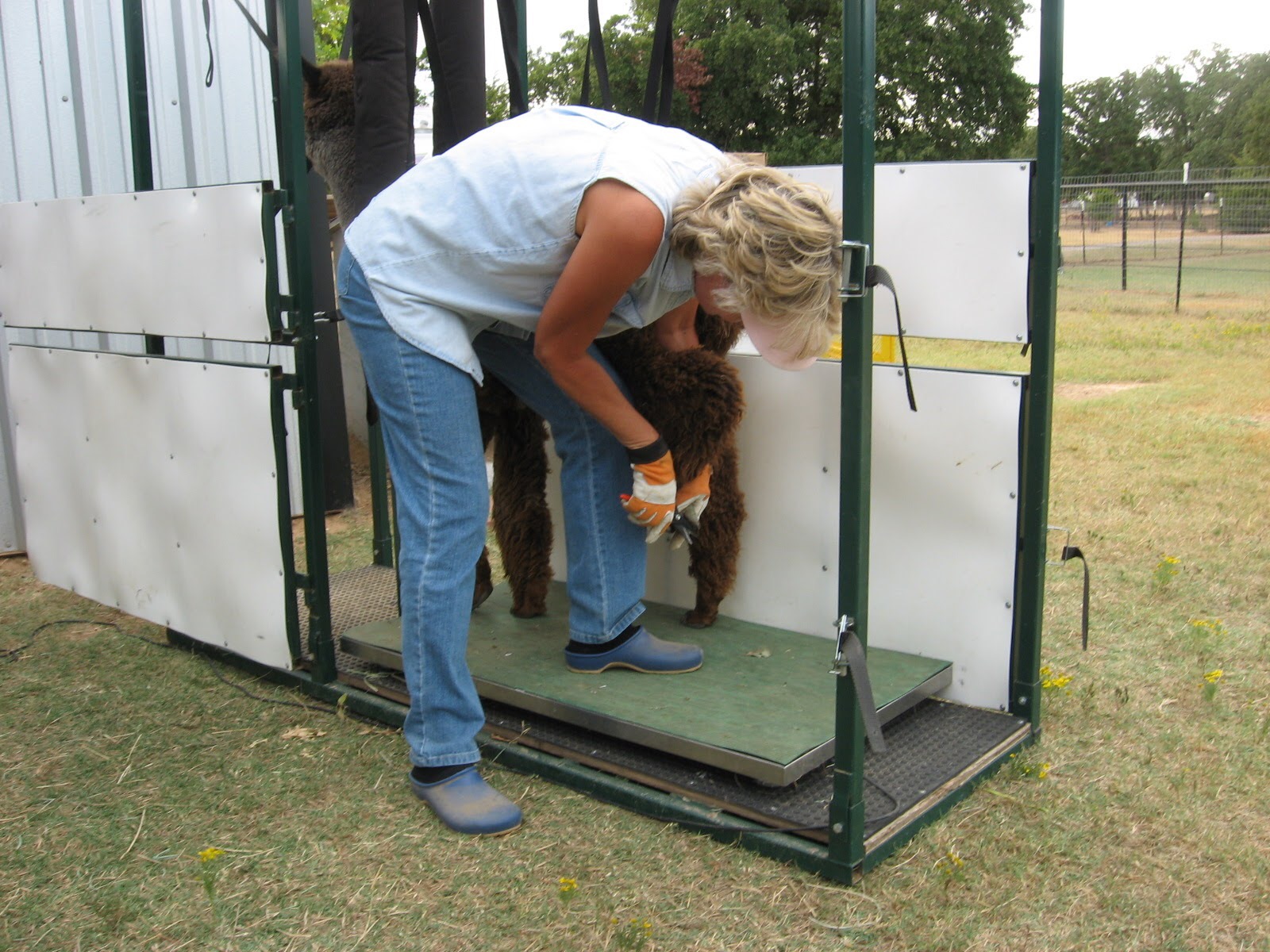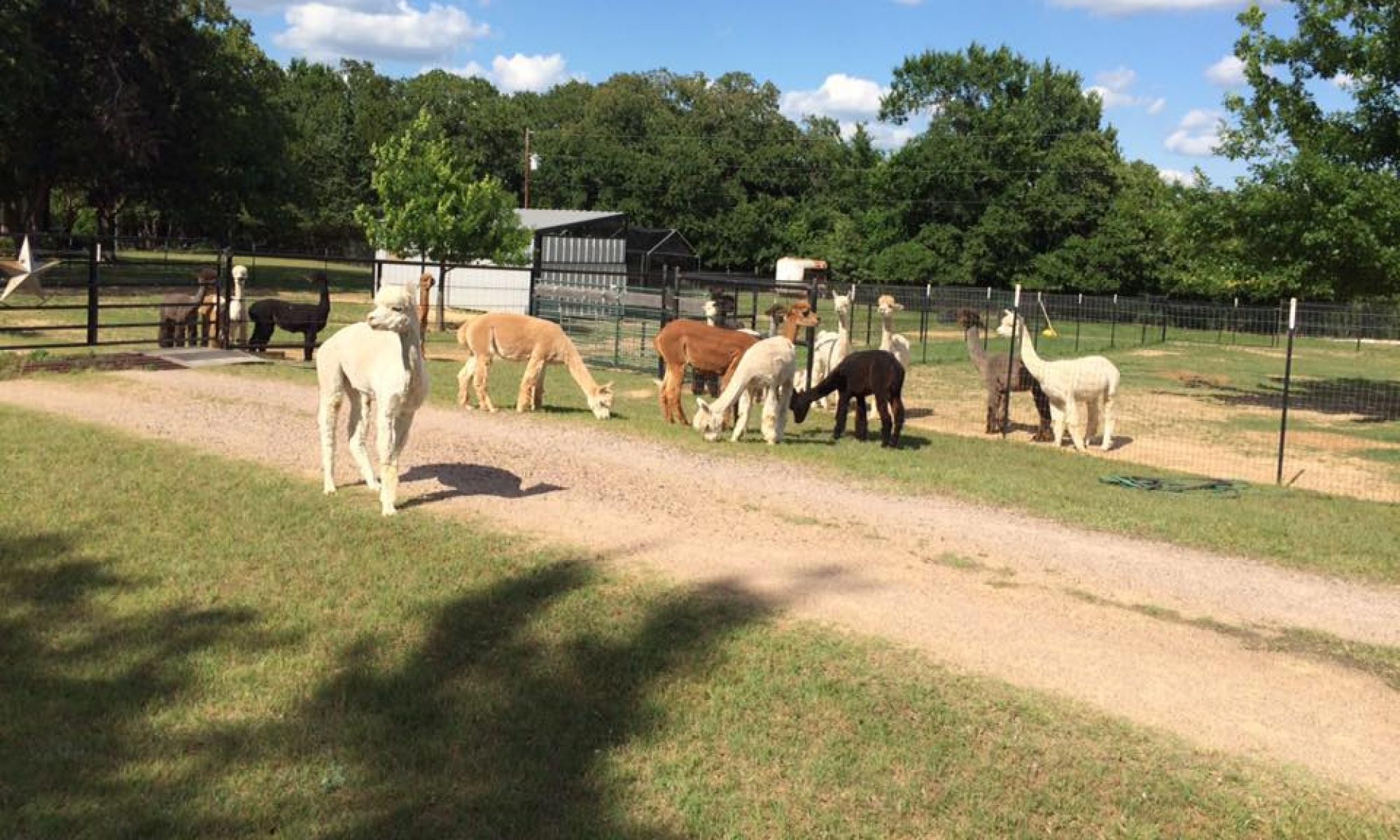Always do monthly herd health and keep written records. We have a form we use if you want us to send it to you. Debbie’s nursing background has led her to transcribe the field notes on this form into more of a permanent record for each individual Alpaca. Again, a shareable form if you want it.
Others use electronic applications designed specifically for the Alpaca industry. We began with one but are more comfortable with our manual recording techniques.
Consider buying a physical restraint device like an Alpaca Chute (we bought one at the very beginning) or a Paca Trapper for use with Herd Health days. If you choose not to obtain one, learn to keep the Alpaca well balanced on three legs as you pick up each foot for nail trimming. It’s easier with two people. Tying them to a shed wall is also helpful.
Buy a digital animal scale; 300 lb weight limit with .1 to .2 lb increments is fine. We place ours in the Chute.

What to check
We check the following each month during Herd Health:
- Weigh monthly. Most mature Alpacas will usually be between 125-175 lbs. Crias should gain at least .25 lbs and .50 lbs per day. Weigh them daily at first.
- Eyes for clarity, cataracts, damage, and drainage
- Eyelids (conjunctiva) using the FAMACHA Scale. This is a good way to observe anemia issues which can be related to either parasites or lack of iron.( See: https://web.uri.edu/sheepngoat/files/FAMACHA-Scoring_Final2.pdf for in depth information.)
- Ears for smell, appearance or ticks (see below.) Smells and/or discharge is indicative of an ear infection. Get a vet involved immediately. Do not treat with things like hydrogen peroxide. The Alpaca ear canal is L-shaped and cannot drain liquids as easily as a human ear. Very tiny amounts of Ivomec to prevent ear tick infestations is an exception to this advice.
- Teeth grow all of an Alpaca’s lifetime. Front teeth are inspected for damage, growth patterns and deformities. In rare occurrences the front teeth might need to be trimmed. A Dremel Rotary tool or Tooth o Matic device can be used to this end. The teeth should normally align at the front of the upper dental pad.
- Feel along the jaw line where their molars are for swollen or tender spots. Get a vet involved if problems are found. Abcesses are always possible.
- Body score monthly with your hand just behind thewithers. We use a 9 point scale with 1 = emaciated, 5 = perfect, and 9 = obese. Some Alpacas carry their weight lower so always use in combination with a scale. (While we don’t have a picture of the 9 point scale, an adjustment can be made for the numbers of this 5-point scale found at: http://islandalpaca.com/alpaca_health_care.php#Body_Scoring)
- Check their fleece for parasite issues or skin infections.
- Check underneath the tail for both males and females for signs of drainage, damage or diarrhea.
- Trim toenails monthly. Not all may need it but don’t skip looking at them. White toenails usually grow faster.
- If you suspect any illnesses at all be sure to taken their temperature rectally with a digital thermometer. Test the thermometer to ensure that it is working properly. Get a vet involved if appropriate.
- If you have deer nearby, and you are in an affected area (definitely found in Texas), monthly (28-30-32 days) shots (given subQ )of Ivermectin (or generic) kill extant Meningial worms before the infect the brain. Don’t miss/delay your shots. It’s the cheapest insurance you will ever purchase!
- We give liquid probiotics monthly as the final step. See below for more information.
Syringe Techniques
Using a new/sterile syringe and needle pull back on a syringe with the cap on in the amount medication to be withdrawn before it is inserted into the vial. The top of the vial is cleaned by rubbing with an alcohol pad. When the top is dry the needle is the inserted into the vial while it is resting on a solid surface and the air is pushed in to keep a vacuum from happening. Turn the vial upside down with the needle tip in it. Draw out the desired amount. When I pull up a syringe it usually takes two or three short 1-2 cc “pulls and pushes” to get a solid line of med without bubbles. Pull the needle out of the vial. Recap the needle by scooping the lid up with the needle to prevent inadvertent needle sticks. After it is out of the vial and capped I pull back on the syringe another tiny amount to create a bubble.
When injecting into the Alpaca I keep the needle pointed below a 90° angle. The air bubble rises to the top of the medicine and creates an air lock in the tissue so that the medicine doesn’t leak out. With any route of injection you should withdrawn the plunger prior to injecting. You not only want to ensure you are not in a vein in an IM, but also when doing SQ, if the plunger snaps back it means you are in the right spot. If it doesn’t snap back it means you are sucking air and have gone thru the other side of the skin. These are only for subQ or IM, not IV.
Other Herd Health Issues
Learn about ear ticks at:
Watch your animals (dogs & Alpacas) for head shaking and other symptoms. Consider monthly Ivermectin in their ears to deter infections if your vet agrees. Watch for head shaking. Ticks are not visible to the naked eye.
Use probiotics on a regular basis to ensure good rumen (an Alpaca’s second stomach) health. Don’t give them daily. They are available as a powder which you can use weekly on as a top-dress on their feed pellets. We utilize 5-10 cc of the liquid form per Alpaca. Obtain them from:
https://www.naturs-way.com/prod.htm
Be sure not to order in the hotter months so that it doesn’t degrade their viability.
Read next: Transporting

